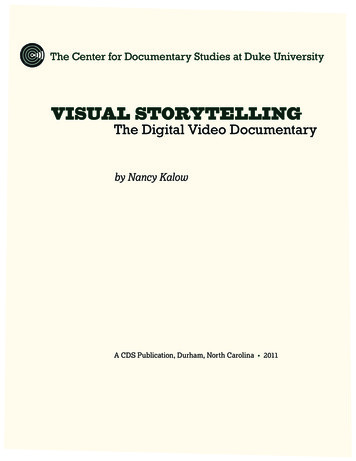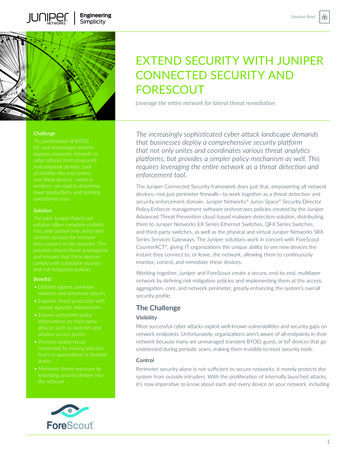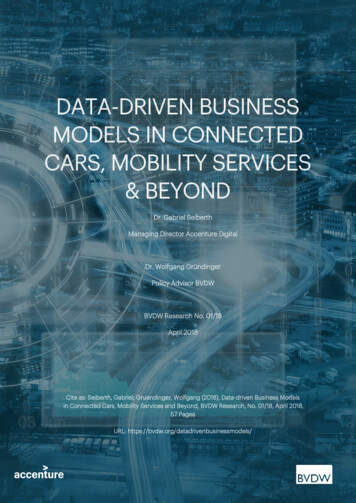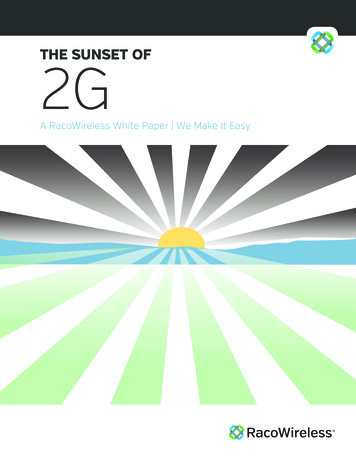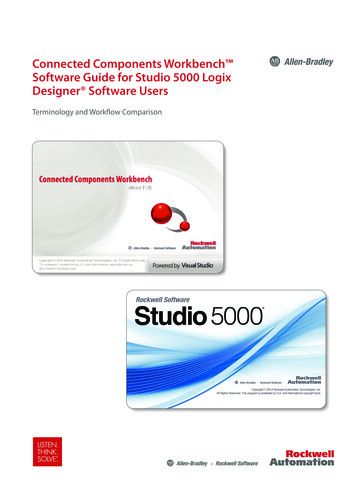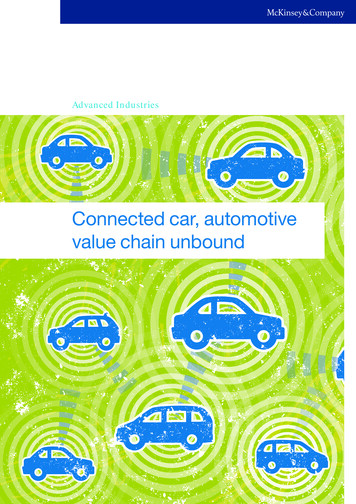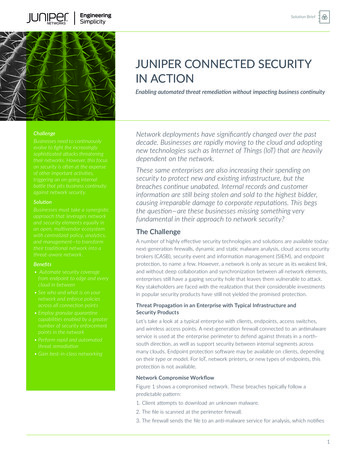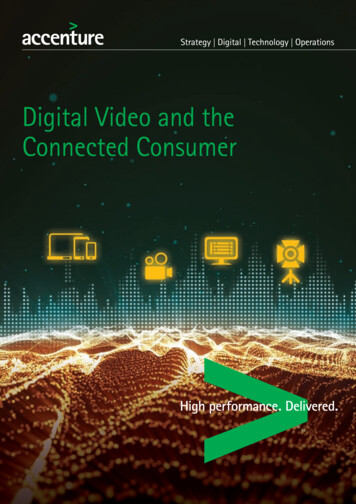
Transcription
Digital Video and theConnected Consumer
Split ScreenTV’s undisputed popularity as the go-to entertainment device isending. Now, as viewers shift their allegiance to other devices,media companies must identify new ways to package contentand share it across multiple screens.Are we watching the death of TV, onmultiple screens? Not yet. But theway viewers consume video contentis changing faster than ever before.The fifth annual multinational‘Accenture Digital Consumer Survey’puts this into focus.Consumption of short-form videocontent on IP-connected deviceskeeps on growing. Take one example:the number of hours YouTube’sbillion-plus users spend watchingcontent on the site is up 50 percentyear-on-year – and over half of allviews are on mobile devices1. Andnow it’s clear that viewership oflong-form video content – likemovies and television shows – isshifting emphatically from the TV toother digital devices (computers/laptops, smartphones and tablets).It’s a dramatic trend. Globally, the TVhas lost 13 percent of its audiencefor this type of content in the pastyear (in the US, it’s an 11 percentdecline). And it’s not just TV showsand movies that are increasinglybeing watched on non-TV devices.Ten percent fewer people around theworld watched sports on a TV screenlast year (Fig. 1).We found that the TV is the onlycategory of device experiencinguniform, double-digit usage declines,across different types of mediaworldwide, among viewers of nearlyall ages. In other words, it’s not just‘screenagers’ who are turning theirbacks on the TV although 14-17year-olds are abandoning TV screensfaster than any other group.Profound changes are taking place inhow all of us consume video content– and they’re happening right infront our eyes (Fig.2).Crucially too, we found that wherepeople are watching TV, they’re doingso in combination with at least oneother device. 87 percent ofconsumers are also using theirsmartphone, tablet, game console,ebook or laptop whilst watching TV.In other words, the second screen isfirmly established as a key element ofthe value proposition for all mediacompanies.For incumbent TV broadcasters,satellite and cable providers, theseare truly pivotal developments. Oursurvey shows that consumers stilltrust established brands more thandisruptive digital players. But withthese same consumers switching1. Source: April 2015, ir allegiance from the TV to otherdevices, it’s the new market entrantslike Netflix, Amazon and BlinkBoxthat stand to win. Built aroundplatforms that can capture andcapitalize on the rich consumer dataflowing from IP-connected devices,they’re able to exploit seamlessfeedback loops between theiraudiences and their operations – bylistening to their customers andtailoring content and services to thisnew reality. The incumbents MUSTcatch up to avoid squandering theirbrand advantage.The proliferation of digital consumerdevices is generating a wealth ofusage data that can only beharvested through digital platforms.Development of these platforms, andsupporting talent and capabilities, istherefore a top priority. Forincumbent broadcasters,programmers and content makers,what’s needed is a marriage of artand science – decisive competitiveedge will be the prize fororganizations that can enhancedecades of content creation, curationand editorial experience with thefeedback that audiences are now sowilling to share.
Figure 1: Preferred device when accessing different types of digital content% Users selecting 1 or 2 preferred devices for each of the digital contentTV Shows / MoviesVideo Clips 9%38%8% 3%8% 4%54%25%15%-13%52%Sport Games / Matches19% 1% 2% 3%8% 4% 6%23%6% 3%-3%-10%43%% Movement from last yearSource: 2015 Accenture Digital Consumer Survey.Figure 2: Frequency of accessing digital content% Users that are accessing content “daily” AND “weekly”AgesTV Shows / Movies14-1718-34 16%44%47%35-54 10%34% 11%16% 9%11% 3%5% 1%16% 12%9% 4%7% 4%29%-33%46%-14%55 58%23%1%3%-11% 8% 0% 1%64%-6%% Movement from last yearSource: 2015 Accenture Digital Consumer Survey3
Reports of TV’s demise are premature, but None of this is to say that TV’sdemise is imminent. In America, forinstance, TV viewing is still thefavorite entertainment pastime –and by a long way. But our surveyshows that people, across agegroups and geographies, arespending more time surfing the weband watching streaming services,and less time in front of theirtelevisions.Why? A number of reasons comeinto play: not least smartphoneswith larger screens which make iteasier to view video content onthe-move, away from home and,indeed, at home. The trend forbinge-viewing series like BreakingBad and Game of Thrones on OTTplatforms adds momentum. A recentsurvey shows why. One-third of allrespondents in the Arris 2014Consumer Entertainment Index saidthey use their mobiles for bingeviewing, with one quarter usingtheir laptops2.And looking ahead, we’re seeing anumber of emerging trends thatpoint to an accelerated shift awayfrom the TV as the primary screen.Availability of live linear, for example,with sports viewing on mobiledevices is gaining traction (shown bytraffic through Star India’s “hotstar”and starsports during the 2015Cricket World Cup). Increasedavailability of content offline isanother factor, with increaseddownloads of content acrossgeographical barriers (e.g. DISH’sinternational package and Starz’snewly launched subscription onlinevideo service – Starz Play Arabia –aimed at young viewers connectingvia mobile devices). And, althoughyet to have a significant impact, thepredicted increase of in-car viewing(as connected/driverless cars enterthe mainstream) will further fuelout-of-home video consumption.73%62%Sports Gamesor MatchesBooks/TextbooksGamingSource: 2015 Accenture Digital Consumer Survey2. Source: April 2015, ine content consumption is nolonger the preserve of early adopters.In fact, frequent access to digitalcontent is now the norm. Globally, 78percent of consumers are watchingvideo clips online daily and weekly;76 percent are watching TV showsand movies either via the internet orthrough a dedicated app.Capitalizing on the digital surge,we’re seeing increasing disruptionfrom “cord cutters” on both sides ofthe Atlantic. This is starting totransform how viewers watch andpay for TV – and it’s a trend thatextends far beyond Netflix, Amazonand YouTube. Significantly, the samelive channels and shows thatbroadcast on TV are bypassing cableRecent research by tracking firmNielsen throws existing developments contracts and streaming straight tothe viewer. Media companies rightinto stark relief. It shows howacross the spectrum are in on thegrowing numbers of households inact: HBO’s doing it with HBO Now.the US are opting to dump their TVsCBS is doing it with Live TV. Dish isaltogether and go “broadband only”(2.8 percent of all households neither doing it with Sling TV. Sony’s doing itwith PlayStation Vue. And Apple willbe doing it later this year.Figure 3: Frequency of accessing digital content% Users that are accessing content “daily” AND “weekly”59%subscribe to cable nor pick up abroadcast signal, almost three timeslast year’s total).76%78%TV Shows/MoviesVideo Clips83%Newspapers91%Social
5
Welcome to the multi-screen worldMulti-screen usage is now a fact oflife for most of us. Whether we’rechecking emails and tweetingcommentaries while watching asports game on TV, or catching up ona favorite program while traveling,we’re all viewing more and moredigital content on a screen or deviceother than our traditional TV.these devices to access all kinds ofcontent on a daily basis (Fig.4).50 percent of multi-taskers). Drillingdown deeper, it was less surprising tofind that smartphones are preferredWe found that as many as 87 percent by 14-17 year-olds, and computers/of consumers are now using the TVlaptops by 45-54 year-olds (Fig.5).and a second screen together, inways that complement each other,Clearly it’s time for media companieswhether that’s getting moreto continue developing a newinformation on a TV program,generation of services that plug intoaccessing social media to getthis second-screen phenomenon.Our survey shows that overall 37reactions to what they’re watchingViewing habits will need to bepercent of consumers now own aon the TV screen, or shopping online integrated into existing offerings tocombination of smartphones, laptops, (particularly popular amongst TVcapture loyalty and help drivedesktops and tablets. It also foundviewers in the Asia-Pacific region).additional revenues, and the abilitythat 16 percent of consumers own a The smartphone is the most frequent to deliver a seamless experienceconnected TV, in addition to acompanion device (for 57 percent of across devices looks set to be ancombination of these other devices.multi-tasking viewers), just ahead of increasingly important differentiator.And more importantly, they’re usingcomputers/laptop devices (favored byFigure 4: Combined product ownership of major device categories per eden% Consumers in Each Country owning acombination of Tablet, Laptop/desktopand Smartphone15%USA40%16%16%FranceSouth AfricaGermanySample base: all respondents N 24000Source: 2015 Accenture Digital Consumer Survey640%16%UK% Consumers in Each Country owning acombination of Tablet, Laptop/desktop,Smartphone and Connected TV49%19%Italy37%58%35%15%36%33%6%15%
Figure 5: Consumers multi-tasking by using more than one device simultaneously% Multi-tasking users selecting all applicable devices used while watching TVAgesTv Smartphone14-1774%57% 18-3471%35-4459%45-5442%55 27%Tv Laptop/desktop14-1744%50% 18-3449%35-4448%45-5453%55 50%Tv Tablet14-1735%25% 18-3426%35-4429%45-5423%55 18%Sample base: Respondents owning the specific devices and multi-tasking while watching TV N 17048Source: 2015 Accenture Digital Consumer Survey7
Focus on the qualityThe availability of video servicesonline is growing all the time – andso is the number of consumers thatare willing to pay for them(22 percent worldwide, up 4 percentin the past year). Increasingly,however, as consumers view more oftheir content online, we’re seeingquality stand out as a key concern.Expectations of seamless HD contentexperiences are feeding through toIP-connected devices and with 89percent of viewers now watchinglong-form video on connecteddevices, it’s perhaps no surprise tofind that 42 percent are complainingabout advertising placement,buffering, or the time it takes forvideos to load and start playing(33 percent). Underinvestment in thenetwork is clearly beginning to takeits toll (Fig.6).This creates some real opportunities.Respondents said they’d be willing topay for online video services if morevariety of premium content wasavailable, there were less advertisinginterruptions and better video andaudio quality was experienced.Quality is a particular concern forviewers in the Middle East and LatinAmerica. But it’s also a major factorin Europe and the US (for 42 percentand 32 percent of viewers,respectively). Higher investment inbroadband networks will help drivemore viewers online. And mediacompanies that can bridge thequality gap between should reap therewards.It’s evident that providers’investments in network quality willhelp drive better performance incustomer retention. Althoughnetworks’ bandwidth quality hasimproved in the past year, more thanhalf of consumers still report facingpoor internet connections on afrequent basis – via home broadbandand mobile internet. Consumers arenow less prepared than they were ayear ago to pay extra for a morereliable internet connection.Increasingly they expect this to be anintegral “part of the package”.The clock is ticking. Our researchshows that 39 percent of consumersare planning to switch to a newbroadband provider in the next12 months (because of poor qualityinternet), and 43 percent ofconsumers are planning to switch toa new mobile operator in the next12 months for the same reason.Figure 6: Consumers watching long-form video content over the internet on any screenLong form video content consumption% Users accessing TV shows, movies or sport over the Internet89%Top 3 concerns to consumers while watching online video% Consumers selection their first 3 complaintsAdvertisinginterruptions duringthe programInitial time required forbuffering-waiting to playthe videoVideo or sound stopsplaying, or is distortedduring playSample base: respondents over 18yo accessing long-form video content N 21283Source: 2015 Accenture Digital Consumer Survey842%33%32%
Play to your strengthsCrucially, our research shows thatincumbent operators have anopportunity to dominate the newvideo content marketplace –provided they play to theirstrengths. Consumers place farhigher trust in these organizations’ability to deliver quality content andsupport for video-over-the-internetservices (Fig. 7).more seamless feedback, and thenew entrants have all builtplatforms to capture this.It’s these feedback loops thatfacilitate disruptive internet videoproviders to know their audiences,continuously test new content andservices, and respond with realagility and intuition. From now on,understanding consumers andensuring decision-making iscentered on consumer insights willboth be increasingly key to thesuccess and, ultimately, the survivalof incumbent operators. Thisrelentless focus on consumeroptimization will have an impact onall elements of a broadcaster’sbusiness: from content decisionmaking to implementing convergedBut if they don’t act now, they riskwasting this valuable brandadvantage. The new generation ofdisruptive digital players may stillbe less trusted brands, but they’repurpose-built for a digital worldwhere people are increasingly likelyto consume video content viaIP-connected devices other than theTV. These devices allow for muchoperating models and exploitingthe data advantage – usingadvanced analytics to makecontinuous and increasinglyrelevant content recommendationsto individual consumers.Figure 7: Most trusted providers for a quality video over the Internet service on TV screen% Users selecting one preferred provider from the below optionsYour Tv BroadcasterSatellite OperatorOverallNorthAmericaYour CableTv Company31%TelecommunicationBroadband Provider26%21%37%22%14%Internet VideoProvider15%26%Social Media %24%3%4%Source: 2015 Accenture Digital Consumer Survey9
Innovate, differentiate, dominateEvidently therefore, broadcasters need tostart investing aggressively in multidevice platforms, as well as securingteaming relationships that leverage theirfootprints further into the multi-devicespace. A simple repackaging of the sameprogramming available anywhere isunlikely to make the grade.We know consumers are looking formuch more than the same old, sameold. They’re ready and waiting toplace their trust in providers that candeliver the right package, to the rightdevice, at the right price, and withthe right quality. For establishedcompanies, as we’ve shown, there’severything to play for. Provided they10can develop the digital capabilitiesthey need to establish and sustaindirect relationships with theirconsumers, customize content andexperiences, and engageeverywhere, they’ll be able to buildon their existing brand advantageto powerful effect.
11
About AccentureAbout Pulse of MediaAccenture is a global managementconsulting, technology services andoutsourcing company, with more than323,000 people serving clients in morethan 120 countries. Combiningunparalleled experience, comprehensivecapabilities across all industries andbusiness functions, and extensiveresearch on the world’s most successfulcompanies, Accenture collaborates withclients to help them become highperformance businesses and governments.The company generated net revenues ofUS 30.0 billion for the fiscal year endedAug. 31, 2014. Its home page iswww.accenture.com.Digital Video and the ConnectedConsumer forms part of the Pulse ofMedia study. Pulse of Media is based on acollection of hypotheses developed byAccenture subject matter advisors,strategy consultants, architects andengineers working in the field. Thesehypotheses have been screened againstinputs from an array of sources includingthe 2015 Accenture Digital ConsumerSurvey, third party data analysis,academic literature, the flow of venturecapital funding and dialogue withindustry commentators, operators anddisruptors. Join the conversation#pulseofmedia or please visit www.accenture.com/pulseofmedia.AuthorsThis document is produced by consultantsat Accenture as general guidance. It isnot intended to provide specific advice onyour circumstances. If you require adviceor further details on any matters referredto, please contact your Accenturerepresentative.This document makes descriptivereference to trademarks that may beowned by others. The use of suchtrademarks herein is not an assertion ofownership of such trademarks byAccenture and is not intended torepresent or imply the existence of anassociation between Accenture and thelawful owners of such trademarks.Copyright 2015 AccentureAll rights reserved.Accenture, its logo, andHigh Performance Deliveredare trademarks of Accenture.Gavin MannGlobal Managing Director,Accenture BroadcastingFrancesco VenturiniGlobal Managing Director,Accenture Media & EntertainmentRobin MurdochGlobal Managing Director,Accenture Internet & SocialBikash MishraSenior Manager, Accenture StrategyGemma MoorbyAccenture Media & EntertainmentBouchra CarlierSenior Manager, Accenture Research
broadcast on TV are bypassing cable contracts and streaming straight to the viewer. Media companies right across the spectrum are in on the act: HBO’s doing it with HBO Now. CBS is doing it with Live TV. Dish is doing it with Sling TV

